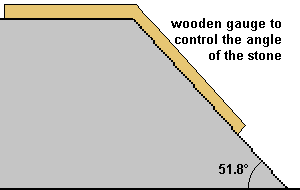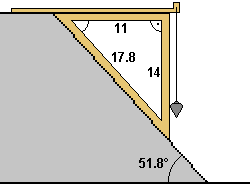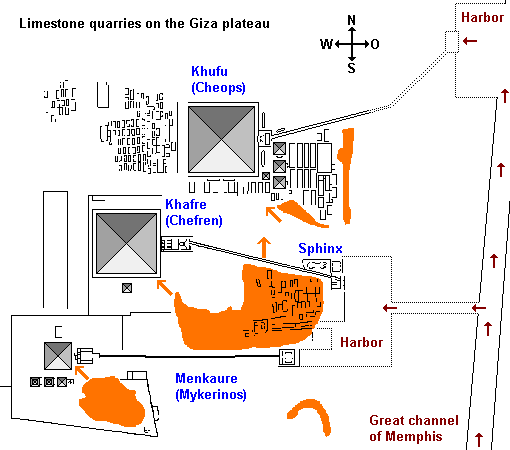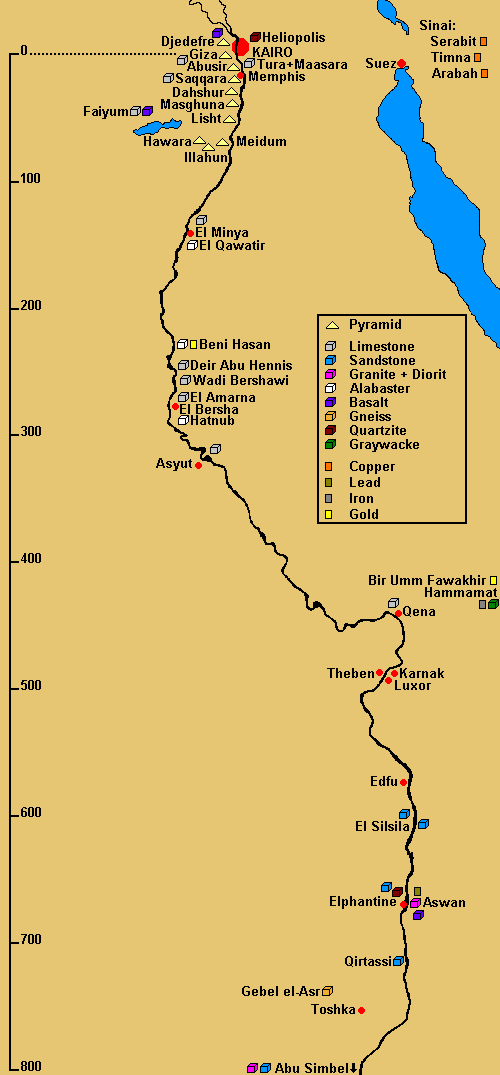Quarries in Ancient Egypt
The pyramid construction project had to be planned methodically from
quarrying the right kind and size of stone to transporting them to Giza
at the right time. The stones came from several different quarries - the
bulk from limestone quarries on the Giza plateau itself, then white limestone
for the outer stones from Tura upriver and granite from Aswan. Smaller
amounts of basalt and Graywacke were also used.
Properties of the stones - Aswan
stone quarries (granite) - Tura stone quarries (limestone)
- Giza stone quarries (limestone) - Quarries
in Ancient Egypt - Sources
Important pages about the stones used for the pyramid:
![]() Cutting granite with iron tools
Cutting granite with iron tools
![]() The outer casing stones of the pyramid
The outer casing stones of the pyramid
![]() The pyramid building yard - the center of
the construction project
The pyramid building yard - the center of
the construction project
 Properties of the stones used for building the Great Pyramids
Properties of the stones used for building the Great Pyramids
| Granite [3] | Limestone [3] | |
| Density | 2600 - 2800 kg/m³ | 2600 - 2900 kg/m³ |
| Water Absorption | 0,2 - 0,5 % | 0,2 - 0,6 % |
| Compressive strength | 160 - 240 N/mm² | 80 - 180 N/mm² |
| Bending strength | 10 - 20 N/mm² | 6 - 15 N/mm² |
| Abrasion resistance | 5 - 8 cm³/50cm² | 15 - 40 cm³/50cm² |
| Mohs hardness | 6-8 [4] | 4 [4] |
| Properties | Granite from Assuan has a specially nice pink color (light pink to dark pink) | Limestone from the Giza plateau has well visible fossils (Nummulites) |
If you look at these numbers you see why it is doubtful, that these rocks
could be cut with copper tools (Mohs hardness 3). Franz
Löhner is sure - without using iron (Mohs hardness 4.5, wrought iron
7-8 [5]) it is not possible!
![]() Cutting granite with iron tools
Cutting granite with iron tools
 The Aswan stone quarries (granite)
The Aswan stone quarries (granite)
Aswan (Assuan) lies 934km south from Giza up the Nile river (about 700
km air-line distance). The granite quarries lie south and southeast of
the city of Aswan on the right side of the Nile and cover an area of about
20 km². The granite for the pyramids probably came from the northern
part. For the construction of the pyramids the ancient Egyptians only
used building stones in perfect condition and that is only a stone
which has been split off. Some archeologists assert [2],
that also weathered roundish granite boulders were used, this kind of
stone always has small fissures and can break apart easily, so it is unsuitable
for use as a building stone.
![]() Photos
quarry Assuan / Google
Earth pictures / Rose granite 1
2
3
/ Gray granite 1
2
/ Diorite 1
2
3
Photos
quarry Assuan / Google
Earth pictures / Rose granite 1
2
3
/ Gray granite 1
2
/ Diorite 1
2
3
| Pyramid | Where was granite used? [1 and 2] |
| Djoser 2624-2605 Saqqara |
Sarcophagus made from granite / burial chamber |
| Sneferu 2575 - 2551 Bent Pyramid, Red Pyramid, Saqqara |
-- |
| Khufu 2551 - 2528 Giza |
Grand Gallery and the King's chamber, sarcophagus. Granite beams (1.3 x 1.8 x 8m, 50-60t) for the relieving chambers and granite portcullis slabs. Pyramid temple with granite columns and basalt pavement around the pyramid. |
| Djedefra 2528 - 2520 Abu Rawash |
Probably the whole outer casing |
| Khafre 2520 - 2494 Giza |
Volume of 17'000m³ [1]: sarcophagus, lowest layer of the outer casing, funerary temple with 2 Sphinx statues (80t) and granite columns (14-19t), granite statue of Khafre |
| Menkaure 2490 - 2472 Giza |
Volume of 15'000m³ [1]: burial chamber, the lowest 16 layers of the outer casing and for the satellite pyramid Menkaure IIIa the lowest layer or perhaps the whole outer casing, blocks of the funerary temple (3 x 5.3 x 8m, 100-200t) |
| Shepseskaf 2472 - 2467 Dahshur |
The lowest layer of the outer casing of the mastaba |
| Neferirkare 2446-2427 Abusir |
The lowest layer of the outer casing or more? |
An earlier pyramid, Djoser's pyramid, also had an inner granite chamber, but for the construction of Khufu's pyramid hard granite was used for the first time on a grand scale, mainly for the burial chamber, the passages and for the sarcophagus [1]. For the pyramids of Khafre and Menkaure again large quantities of granite were used for building, actually the first 16 outer stone layers of the pyramid of Menkaure are entirely of granite [2].
Franz Löhner shows, that granite can't be processed without iron tools (see cutting granite with iron tools). He thinks, that the changes toward slowly using more and more granite for important buildings is consistent with his assumption, that the iron needed to split and cut granite was traded for with the Hittites and only after some time there were enough iron tools available that larger quantities of granite could be cut.
 The Tura stone quarries (limestone)
The Tura stone quarries (limestone)
The Tura quarries (or Maasara quarries) lie south of Cairo on the eastern shore of the Nile, about 13-17km from Giza. These quarries yield limestones of a very high quality - white, very fine-grained, not very porous and somewhat harder than the limestone from Giza. Tura limestone can easily be cut and formed but when being exposed to air it hardens after a certain time. Because the stones weather to a slightly yellowish tone, they were extracted already during the time of building the pyramids from layers deep down, and even from underground. The whole area where the quarries lie is almost entirely stratified horizontally, so the stones are relatively easily extracted. The stone layers are 0.8 to 1.5m thick and separated by small clayey layers. This is the reason, why the blocks can be detached from the bedrock simply by lifting them up [2].
 If
possible stones intented to be laid down on the pyramid next to
each other were also broken next to each other
in the quarry. This automatically meant, that the blocks were of the same
height and that they fitted to each other along the line of cleavage (breakage).
So after splitting the stones, the quarrymen only had to control the longitudinal
side and check if the line of breakage really fitted to each other. This
had to be done carefully, because only small changes could still be made
after the stone had been transported up the pyramid. If the stones didn't
fit well, this was changed with hammer, chisel and other tools.
If
possible stones intented to be laid down on the pyramid next to
each other were also broken next to each other
in the quarry. This automatically meant, that the blocks were of the same
height and that they fitted to each other along the line of cleavage (breakage).
So after splitting the stones, the quarrymen only had to control the longitudinal
side and check if the line of breakage really fitted to each other. This
had to be done carefully, because only small changes could still be made
after the stone had been transported up the pyramid. If the stones didn't
fit well, this was changed with hammer, chisel and other tools.
Cutting the correct angle and the corner stones:
The outer casing stones had to be bevelled in the correct angle (52°)
for the flank of the pyramid, this was done with hammer and chisel and
controlled with a special wooden gauge (illustration above). The quarrymen
paid special attention to the corner stones. These stones had to support
and absorb the enormous weight of the pyramid that pressed down and sidewards,
so they had a special shape and were very massive. The angle of the very
corner was very difficult to achieve and asked for high precision in workmanship.
The outer stones all had to be very precisely cut, because here
the angle of inclination of the pyramid was defined.
![]() Alignment of the pyramids and controlling
the shape of the pyramid
Alignment of the pyramids and controlling
the shape of the pyramid
![]() The outer casing stones of the pyramid
(corner stones)
The outer casing stones of the pyramid
(corner stones)
 Here
at the quarry the stone can be lifted up, canted and worked on all sides.
This is not possible if done on the pyramid itself. Before leaving the
quarry, a master stonemason controls the size, shape of the stone and
if it is smoothed enough at the right places exactly, the way it is necessary
for its intended place on the pyramid. Only after passing this inspection,
the stone is tied to the sledge and brought down to the harbor. Here it
is transferred to special ferry boats, similar to the ships for the granite
blocks and then transported to the Giza harbor. The Tura stones had to
be handled with special care when loading them on the sledges. The wooden
levers were wrapped with straw and the cargo was specially secured.
Here
at the quarry the stone can be lifted up, canted and worked on all sides.
This is not possible if done on the pyramid itself. Before leaving the
quarry, a master stonemason controls the size, shape of the stone and
if it is smoothed enough at the right places exactly, the way it is necessary
for its intended place on the pyramid. Only after passing this inspection,
the stone is tied to the sledge and brought down to the harbor. Here it
is transferred to special ferry boats, similar to the ships for the granite
blocks and then transported to the Giza harbor. The Tura stones had to
be handled with special care when loading them on the sledges. The wooden
levers were wrapped with straw and the cargo was specially secured.
![]() Shipping
the stone blocks down the Nile to Giza
Shipping
the stone blocks down the Nile to Giza
![]() Detailed calculations how many workers
were necessary to build the pyramid
Detailed calculations how many workers
were necessary to build the pyramid
Please take note, that it is very important, that the stones
were cut and bevelled at the quarries and not on the pyramid itself
like it is proposed by most Egyptologists!
![]() The outer casing stones of the pyramid
(reasons why)
The outer casing stones of the pyramid
(reasons why)
 The Giza stone quarries (limestone)
The Giza stone quarries (limestone)
The stones used for Khufu's pyramid is a gray-yellow colored nummulite limestone and belongs to the Mokattam formation. The Giza quarries only lie a couple hundred meters south from the pyramid of Khufu. Then the plateau itself where the pyramid lies was also used for quarrying stones [1].
The pyramid builders used stones of different size and height for the layers. The stone blocks of Khufu's pyramid were very large in the lower layers (1m x 2.5m and 1-1.5m high, 6.5 - 10 tons). For the layers higher up it was easier to transport smaller stone (1m x 1m and 0.5m high, 1.3 tons) [2]. For calculations most Egyptologists use 2.5 tons for an average stone block.
Petrie [6] measured the pyramid layers and noticed,
that while the stones used for the layers of Khufu's pyramid overall get
smaller the further up you go, again and again there are stones layers
much thicker than the ones before. Franz Löhner thinks this is evidence,
that the stones in one layer originated (if possible) from the same stone
layer in the quarry and then were layed down on the pyramid next
to each other.
![]() Stone courses of the Pyramid of Khufu
Stone courses of the Pyramid of Khufu
This fact also speaks against the huge transport ramps
- when employing a ramp it is crucial to use smaller stones further up
because the ramp gets narrower and often also steeper. But while building
Khufu's pyramid with the help of Löhner's rope roll the haulers must
have gained enough experience to be able to transport even relatively
large blocks up to greater heights. Thicker layers are also necessary
to install intermediate rope roll stations.
![]() Transport up the pyramid flank with Löhner's
rope roll
Transport up the pyramid flank with Löhner's
rope roll
![]() The pyramid building yard - the center of
the construction project
The pyramid building yard - the center of
the construction project
The archeologist Mark Lehner says, that the rubble covering the Giza
quarries nowadays is what is left over after dismantling the transport
ramps. But even if you think transport ramps are necessary - why cover
up a perfectly good quarry which still can be used for many generations
after the pyramid has been built (for example stones from Menkaure's quarry
were used for tombs in Abusir [2])? Actually it
is more likely, that rubble and sand have accumulated there after the
quarries were abandoned because they were no more profitable.
![]() Theories of pyramid ramp systems disproved
Theories of pyramid ramp systems disproved

Orange = Limestone quarries on the Giza plateau. Dashed
line = harbor facilities, their exact position is not known
There is a building in the harbor of Khafre which is about
70m long and there seemed to be two piers there. The stone blocks from
Tura and Aswan were brought here on the Nile channel. The walls of the
channel and the harbor were probably used to moor ships transporting materials
like wood, ropes and other building materials.
![]() Shipping
the stone blocks down the Nile to Giza
Shipping
the stone blocks down the Nile to Giza
 Quarries in Ancient Egypt
Quarries in Ancient Egypt
Quarries for many different types of stones lie along the Nile. Most stones were transported on barges down the Nile. Granite for the King's Chamber in Khufu's pyramid was brought over more than 900km from Aswan and white limestone for the outer casing from Tura, a few kilometers south of Giza.
Map of quarries in Egypt - print version
Map of stone quarries for limestone, sandstone, granite, basalt and alabaster [2] and mines for copper, iron, lead and gold [3] in ancient Egypt. Print only map.
 Sources
Sources
[1] J. Röder Zur
Steinbruchgeschichte des Rosengranits von Aswan
[2] R. and D. Klemm Steine und Steinbrüche
im Alten Ägypten
[3] Geo Dienst - List
of rocks (in German)
[4] D. Arnold Building in Egypt
[5] Mohs' scale of mineral hardness characterizes the scratch resistance
of various minerals through the ability of a harder material to scratch
a softer material. A fingernail has a Mohs hardness of 2.5 / copper penny
about 3.5 / a knife blade 5.5 / window glass 5.5 / steel blade 6.5.
[6] W. Petrie The Pyramids and Temples
of Gizeh - Illustration
stone layers
| Copyright 2006: |
Franz Löhner www.cheops-pyramide.ch | |
| Concept and Design, English Texts: |
Teresa (Zubi) Zuberbühler www.starfish.ch |
